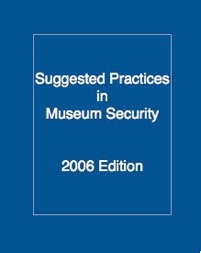Guidelines and Standards

A standard is a document written by a standards organization whose mission is to prepare technical or other instructions for doing something. Standards are the technical norm or method of doing something. In the security field we work regularly with standards that pertain to health and safety, deal with the disabled, with door and hardware, security and fire. Some standards are adopted by cities and states as codes or laws.
There are several very common sets of standards that we deal with. The most common is the fire standards published by the National Fire Protection Association (NFPA). We can’t provide copies on this website due to copyright restrictions but a special section of this website which deals exclusively with fire issues addresses the various fire standards that should be part of every museum security professional’s bookshelf or museum’s library.
Similarly, the Underwriters’ Laboratories (UL) standards play an important role in museum security and these, too, are protected by copyright but can be obtained from their authors. Generally, you don’t need to buy UL standards. There are too many of them and they are largely irrelevant to your day to day duties. Just know that any security systems that you use must be UL “listed” for their purpose. This means that if an access control system is UL “listed” for access control but not for burglar alarm monitoring, you can’t use it in your museum for alarm monitoring and if a smoke detector is UL listed for mounting on a ceiling, you can’t mount it on the wall. UL is an organization operated by the insurance industry that assures that security and fire equipment functions as it should.
NFPA 101 is the Life Safety Code. Some municipalities have adopted it and others have adopted more stringent requirements. The primary contact we have with this document involves using delay locking devices on doors out of your museum. This document gives all of the requirements in order to be allowed to use delay locks and defines how long the doors can be delayed before the must open. The section that pertains to 99% of all museum contacts with this code is “Special Locking Devices”. You can get a copy from the NFPA. See the referrals page of this website.
The most important standard for museum security is the “Recommended Guidelines for Museum Security” (later re-titled as the “Suggested Practices in Museum Security”) which is not officially a standard. Nevertheless, it is extremely important to you and you should not only have a copy of it on your bookshelf, you should adopt this document and work toward total compliance.
What Are Guidelines & Standards?
The “Guidelines” as they are called can be downloaded in .PDF format from our downloads page of this website.
In the 1990’s, the insurance industry began a push to demand more security than museums were willing to provide because what they demanded made the museum unwelcoming and gave it a prison-like feel. A blue ribbon committee was formed as part of ASIS to write standards that would define how much security is enough. The AAM committee was instrumental in this effort and the result was a document called the “Recommended Guidelines in Museum Security” jointly endorsed by ASIS and AAM’s security committee.
While the document specifically states that it is not a standard, it has in fact become one for all practical purposes. It’s stated goal is to be a lowest common denominator of security for all museums of all types in North America.
We urge you to download and read this document and to adopt it as your institutional security goal. If every museum did this it would only be necessary to ask a borrowing institution if they conform to the Guidelines and if they do, you would have an immediate snapshot of their security with which to make a lending decision. Since representatives of the insurance industry participated in the writing of this standard, the insurers use your compliance as a means of judging your security when making insurance decisions.
Consider the Guidelines to be your friend and an important tool in achieving good security.
Click the cover above to download.
Click HERE to download rare book draft standards for libraries.
Click HERE to download draft off-site museum collection storage standards from ICEFAT.
Use Navigation menu at top of page or go HOME from here.


